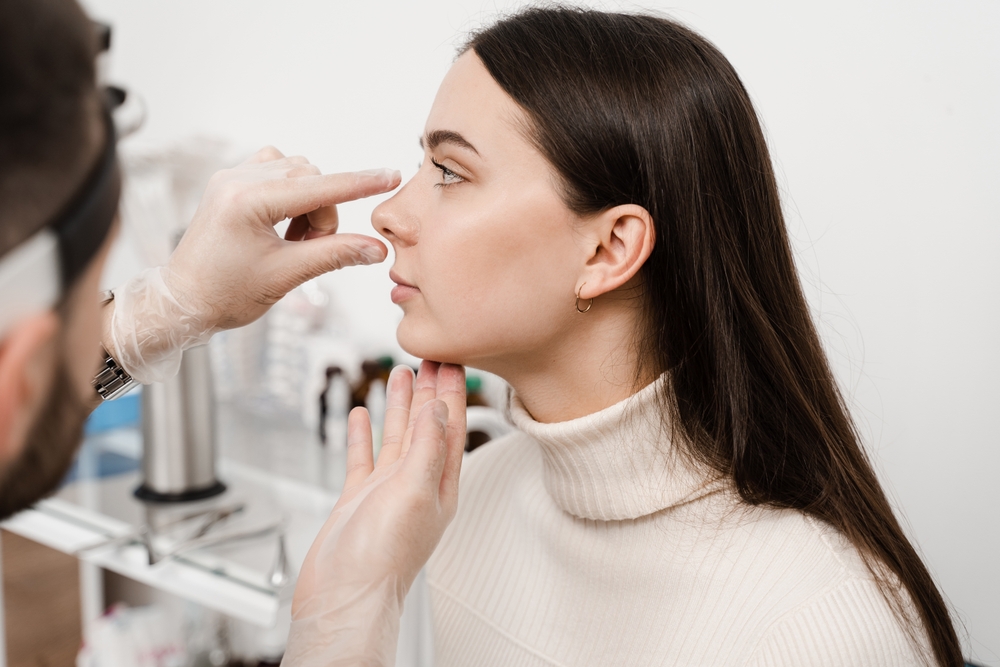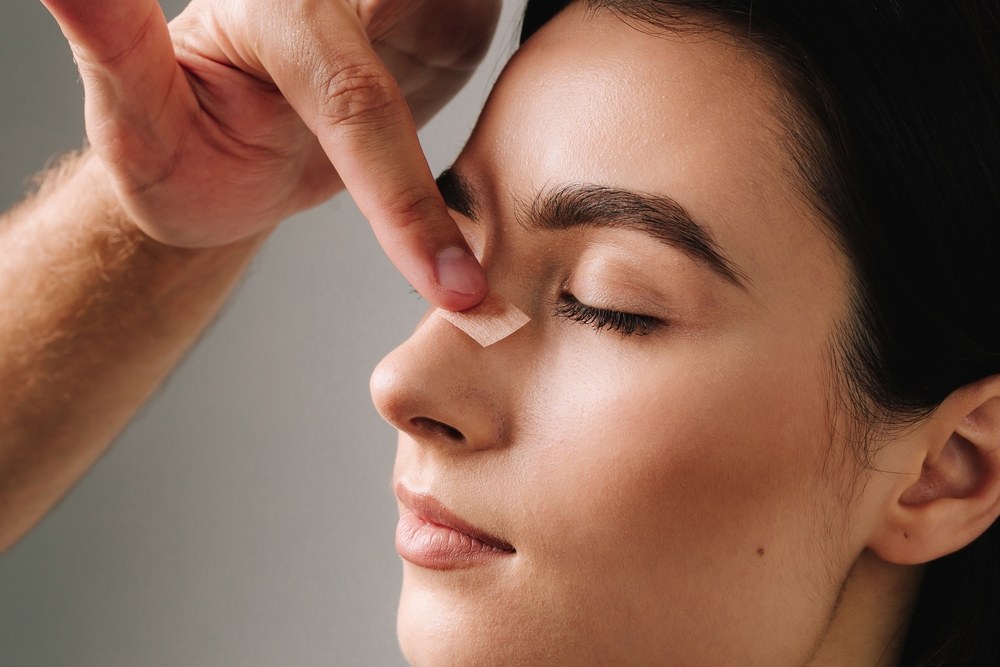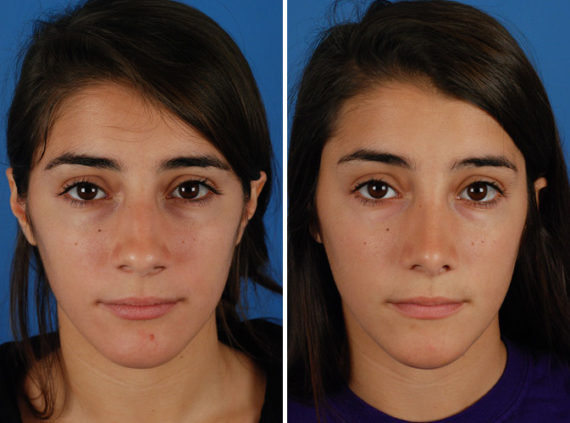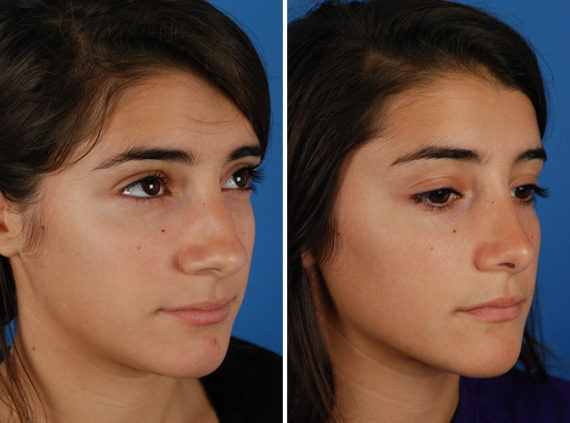It’s not unusual to notice your nasal tip looking slightly lower or different than expected during the months after rhinoplasty. This change, often called “tip drop after rhinoplasty,” can be part of the normal healing process as swelling goes down and tissues settle.
At Aesthetic Surgery Center in Naples, FL, we use our experience in advanced rhinoplasty techniques to help patients understand what to expect during recovery. Our goal is to offer clear, honest guidance so you feel informed and supported every step of the way.

What Nose Tip Drop Means After Rhinoplasty
Tip drop after rhinoplasty refers to the appearance of the nose tip sitting lower than expected as healing progresses. While this can be concerning for patients who anticipated a more lifted or defined tip immediately after surgery, in many cases, this shift is temporary and reflects the natural settling process of the nasal tissues.
The tip of the nose is often the last area to fully refine after rhinoplasty surgery. Swelling, scar formation, and changes in structural support all play a role in how the nose tip ultimately heals. What may seem like a downward shift could actually be swelling resolving from higher areas of the nose, giving the illusion that the tip has dropped.
While some tip drop is expected, noticeable or persistent downward rotation, especially when accompanied by functional or aesthetic concerns, may signal a complication that should be discussed with your facial plastic surgeon.
Healing Timeline for the Nasal Tip After Rhinoplasty Surgery
Every patient heals at a different pace, but there are some general stages you can expect when it comes to how the nose tip looks and feels after rhinoplasty surgery. The appearance of the tip will change over time, especially during the first year of healing.
What You Might See During the First Month
In the first few weeks after rhinoplasty, swelling dominates the nasal appearance. The tip is often swollen and slightly upturned due to surgical manipulation and internal cartilage grafting of support structures.
During this period, the nose tip can feel firm, even numb, and appear more projected than expected. This is normal and reflects the immediate post-surgical state rather than your final rhinoplasty results.
Key expectations during this phase include:
- A more elevated or rotated nose tip
- Noticeable swelling, especially in the lower third of the nose
- Bruising and changes in skin sensation
- Internal pressure or congestion from swelling
Changes Around the Three-Month Mark
By the three-month mark, much of the swelling in the upper part of the nose begins to resolve. As this occurs, the tip may look rounder, softer, or even slightly droopier. This is often the stage when patients first notice what seems like a nose tip drop after rhinoplasty, even though this change may simply reflect shifting swelling and tissue settling.

It’s important to know that this stage is still early in the healing process. The cartilage and tissue are still adjusting, and the skin over the tip is gradually conforming to the new underlying structure.
During this time, patients may see:
- Improved breathing as swelling reduces internally
- Shifts in tip rotation or projection
- Changes in definition along the nasolabial angle
How the Tip Settles Between Six Months and One Year
Between six months and one year, the tip begins to take on a more refined shape. Swelling continues to decrease slowly, and the structural framework created during surgery stabilizes.
Patients can expect:
- Smoother transitions from the bridge to the tip
- Continued softening and definition in the tip region
- Gradual lifting or stabilizing of the nasal tip position
In some cases, minor asymmetries or a slightly lower nasal tip can persist as part of the natural variation in healing. If the tip appears overly droopy or obstructs the nostrils, it may be time to speak with your surgeon.
Long-Term Results and What to Expect Over Time
Final rhinoplasty results are typically evaluated after one full year, although some subtle changes can continue for several years. At this point, the tip’s position should be stable and reflect the surgeon’s intended outcome—barring unexpected complications or healing issues.
If tip drop appears more dramatic or contributes to functional concerns (such as nasal valve collapse or breathing difficulty), revision rhinoplasty may be discussed. However, many mild cases of tip drop resolve or improve naturally over time as swelling fades and scar tissue softens.
Before & After Photos
* Each patient is unique and individual results may vary.
What’s Actually Happening Under the Skin
Understanding what causes changes in the nose tip’s appearance during recovery can help ease anxiety and support realistic expectations. Healing involves more than just the surface—it includes cartilage, connective tissue, and scar formation beneath the skin.
Swelling and How It Affects the Tip
Swelling in the nose is not uniform. The nasal tip, in particular, retains fluid longer due to its dense connective tissue and limited lymphatic drainage. This lingering swelling can distort the shape and apparent position of the tip, making it look larger or lower than it will be in the final result.
The external columellar incision can also temporarily interrupt lymphatic fluid drainage of the nasal tip skin, and this improves over the course of the first one year.
Swelling can also shift subtly throughout the day, further contributing to a sense of unpredictability. Taping the nose or using cold compresses may offer temporary relief but won’t drastically affect long-term tip shape.
How Cartilage and Tissue Shape the Final Look
The nose tip is supported by cartilage structures—particularly the lower lateral cartilages—that are reshaped during rhinoplasty surgery. Techniques such as suturing, trimming, grafting, or repositioning cartilage are used to refine the tip’s angle, projection, and contour.
Over time, these structures heal in place. However, the final appearance also depends on how the skin and soft tissue settle over the framework. Thicker skin may result in a softer or rounder look, while thinner skin may better reveal contouring details. It is extremely common for the tip to feel stiffer than pre-operatively due to necessary cartilage grafting utilized to adjust tip definition, projection and rotation.
Scar tissue can also form under the skin and alter how the nose tip feels and looks. This is why experienced surgical technique and close post-operative care are essential to managing tip support during healing.
Why Tip Position Can Shift Even Months Later
The nose is a dynamic structure. Movement from facial expressions, gravity, and natural aging can all contribute to subtle changes over time. Even after nasal surgeries are complete, internal changes may occur for several months—especially in patients with complex nasal anatomy or prior procedures.
Factors that may contribute to tip drop include:
- Weak cartilage support or over-resection
- Loss of tip projection due to scarring or graft absorption
- Skin thickness and elasticity
- Excess downward tension from scar tissue
This is why follow-up care with your surgeon is so important. Monitoring tip position helps ensure that any undesirable appearance is addressed early.
Are You Ready For A Consultation?
You are about to take the first steps towards improving your appearance and enhancing your self-image by learning about contemporary plastic surgery.
Know When Tip Drop Is Normal and When to Talk to Your Surgeon
It’s natural to feel uncertain as your nose changes shape during healing. Knowing the difference between normal changes and potential complications can help you stay proactive without becoming alarmed.
Signs That Are Part of a Normal Healing Process
Some amount of tip drop after rhinoplasty is expected and can be completely normal. These signs typically fall within the expected healing timeline:
- The tip appears slightly lower or more defined as post-surgical swelling decreases
- Mild softness or asymmetry is present but does not affect nasal function
- The nasal tip gradually improves or stabilizes in appearance over time
- No difficulty breathing or signs of nasal obstruction are present
These shifts are usually temporary and can often be observed during routine post-operative visits.
What May Be a Sign to Schedule a Follow-Up
Certain changes may indicate that the nose tip requires further evaluation by your facial plastic surgeon. These signs can include:
- Sudden or progressive drooping after the initial recovery period
- A noticeably pinched, uneven, or collapsed tip
- Difficulty breathing or nasal airflow obstruction
- Significant differences between expected and actual results after one year
- Visible changes in the shape of nostrils or nasolabial folds
If you experience any of these issues, a follow-up appointment is the best way to assess whether revision rhinoplasty or non-surgical interventions may be beneficial.

Choose a Skilled Rhinoplasty Surgeon in Naples, FL
Choosing a qualified, experienced surgeon plays a critical role in how well your nose heals—and how your nose tip looks in the months following surgery. Rhinoplasty is one of the most technically demanding facial procedures, requiring a precise approach that balances structure, function, and aesthetics.
Why Surgeon Experience Makes a Difference
At Aesthetic Surgery Center in Naples, FL, our board-certified facial plastic surgeons and plastic surgeons specialize in advanced facial rejuvenation and nasal surgeries. We use meticulous techniques to preserve or enhance nasal tip support and prioritize results that look both natural and lasting.
Benefits of working with an expert rhinoplasty team include:
- Detailed pre-surgical planning tailored to your facial features
- Structural support techniques to minimize unwanted tip drop
- Post-surgical care that addresses healing concerns early
- A collaborative approach to both cosmetic and reconstructive goals
Whether you’re considering primary nose surgery or exploring options after a previous operation, our team is here to help you feel confident, informed, and heard every step of the way.
Frequently Asked Questions About Rhinoplasty Tip Drop
Not necessarily. In many cases, the appearance of tip drop is temporary and related to how the nose is healing. Swelling and soft tissue changes can make the tip appear lower than it will ultimately be. However, in some instances—especially if structural support was weakened during surgery—a revision procedure may be needed to restore tip position.
The nasal tip typically continues to refine for 12 to 18 months after rhinoplasty. Most of the swelling resolves within the first three to six months, but subtle changes can continue beyond that, especially in patients with thick skin or complex anatomy.
In select cases, mild tip drop can be improved with non-surgical options such as dermal fillers. These can help add projection or smooth contours. However, for more significant concerns, revision rhinoplasty is often the most effective long-term solution. Your surgeon can guide you on the right course of action based on your anatomy and goals.
It’s very common for the nose tip to look asymmetrical at different stages of recovery. Swelling can affect each side differently, and scar tissue can temporarily distort shape. If you’re concerned, bring it up at your follow-up visits. Most unevenness resolves as healing progresses.
Not at all. Week-to-week changes are expected during the healing process. The tip may appear lifted, droopy, swollen, or even change shape slightly as tissues settle. These fluctuations are normal and don’t necessarily reflect your final rhinoplasty results.
Taping may help reduce swelling in the early stages of healing, especially under your surgeon’s guidance. However, it’s not a substitute for surgical support structures. Proper technique during surgery and appropriate post-operative care are more important in determining how the tip heals.
Book a Consultation at Aesthetic Surgery Center
If you’ve noticed changes in your nose tip after rhinoplasty—or if you’re considering surgery for the first time—it’s important to have your questions answered by a trusted professional. At Aesthetic Surgery Center in Naples, FL, we offer personalized evaluations and expert care rooted in decades of experience.
Let us help you understand what’s normal, what’s not, and what’s possible. Schedule your rhinoplasty consultation today and take the next step toward the nose you’ve always wanted—refined, functional, and in harmony with your natural features.

